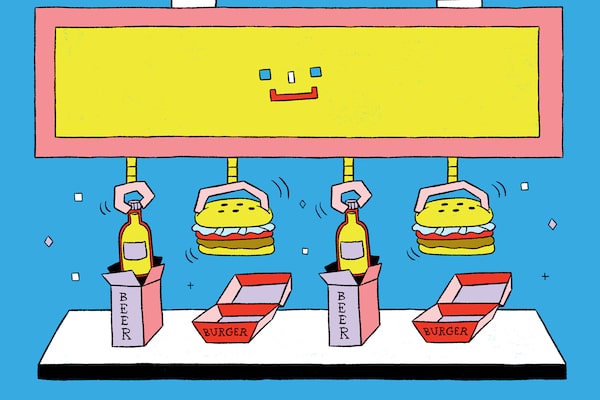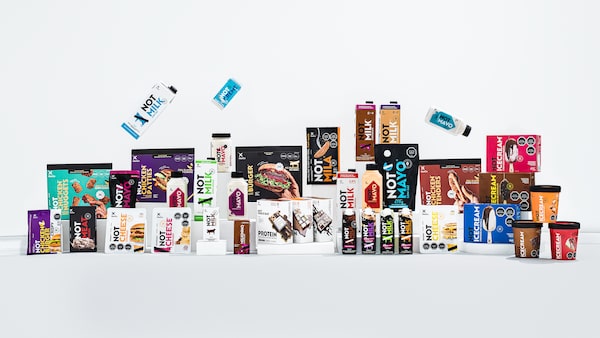
Some food companies have used artificial intelligence to improve efficiency by speeding up assembly lines or distribution. Others have used AI to produce marketing materials, or in customer service.Illustration by Audrey Malo
Like many people, Isaiah Archer first discovered ChatGPT last winter, and quickly began playing around with it. As a partner at a small craft brewery, his prompts for the AI-powered chatbot were initially focused around seeing if the bot could write product descriptions, or “dumb jokes about beer.”
Then one day, Archer asked ChatGPT for a beer recipe. “I’m thinking a hazy pale ale, fluffy and tropical,” he wrote. Within seconds, the bot generated for him a full recipe: how many grams of grains and hops were needed, and how to ferment them to get the desired result.
“To our surprise,” said the co-owner of Whistle Buoy Brewing in Victoria, “it was pretty, pretty spot-on.”
We test-drive a muffin recipe created with AI
Thus “Robo Beer” was born. For Archer and his company, the beer was simply an experiment, meant to test out a new technology and see what they could do with it. They made one batch of Robo Beer – about 800 litres – which sold out quickly, then moved on. Their product was a one-off, but other food businesses have adopted artificial intelligence technology into their mainstream operations: integrating machine learning and predictive models across a much larger scale, and across our food system.
Some food companies have used it to improve efficiency – in speeding up assembly lines or distribution. Others have used AI to produce marketing materials, or in customer service. Wendy’s, for instance, has been working with Google to develop a chatbot to “man” its drive-through windows.
But many companies, too, are using artificial intelligence to develop new foods altogether – relying on robots to come up with new flavours or ingredient combinations that human chefs might not otherwise think of.
“Chefs often rely on accident,” said Bernard Lahousse, founder of the Belgium-based AI company Foodpairing. Whether it’s happenstance or in a fit of inspiration, chefs who come up with truly new ideas – new recipes and flavour combinations – often get there through trial and error, and many, many mistakes.
“What our science helps to do,” he said, “is to not rely on accidents.”
Foodpairing uses a database it created to analyze the aromatic profile of some 1,700 ingredients. The AI technology then helps to identify ingredients – “pairings” that weren’t previously known to share aromatic characteristics. The likes of Ferran Adrià (the pioneer of molecular gastronomy and former chef of El Bulli) and Heston Blumenthal (the British chef behind Fat Duck) have worked with Lahousse to discover new and novel flavour pairings such as “kiwître” (oysters with kiwi), or blue cheese and pineapple.
They’ve worked with big food companies too. When Kellogg’s wanted to develop new Pringle’s flavours that paired well with drinks, they called on Foodpairing. The AI technology helped the company land on a new flavour: roast beef with mustard.

NotCo is an AI food company backed in part by Jeff Bezos. The brand uses an AI platform called “Giuseppe” to help identify plant-based ingredients that can mimic the taste or texture of animal foods.Supplied
In Chile, NotCo, an AI food company backed in part by Jeff Bezos, has developed products for the likes of Kraft Heinz, Burger King and Starbucks. NotCo uses AI to identify plant-based ingredients that aren’t otherwise known to mimic the taste or texture of animal foods. The resulting products, “NotChicken” nuggets and “NotBurgers,” are already available in Canadian grocery stores.
The company’s AI platform even has a catchy name used in all of its marketing materials: “Giuseppe” (after the late artist Giuseppe Arcimboldo, known for painting human portraits that, upon closer inspection, are made up of smaller images of plants and vegetables).
Among “Giuseppe’s” discoveries: that pineapple juice might replicate the milky creaminess of dairy. And that a combination of soy, bamboo fibre and peach powder can come together as “chicken nuggets.”
“We’re approaching the problem differently,” said NotCo CEO Matias Muchnick. By thinking beyond the traditional starting point – of, say, a lentil or soy patty – the technology instead “explores a huge hypothesis space of possible ingredients and then optimizes for the factors consumers care about: taste, texture, appearance.”
The “NotChicken” nuggets are, in fact, a reasonable facsimile for the fast-food nuggets. So long as you eat them straight out of the oven, they’re crispy, salty and savoury. But let them sit too long and the filling becomes sad and mushy.
“NotBurger” patties, made of pea protein, bamboo fibre and rice protein, have the opposite challenge. The texture is an excellent approximation of ground beef. Like a real burger, there’s a variety to the bite, with crumbly and denser, chewy bits. But on flavour, these patties fall down. They taste like dried beans and little else.
For food companies, an undeniable benefit to this technology is a faster, tighter product development timeline. A new food product that used to take 12 to 18 months to develop, says Muchnik, can now be ready to go in just two to three weeks.
The potential upside goes beyond cost-cutting. Advocates of AI also argue that the technology has the potential to help create a better food system overall.
A big part of Foodpairing’s work, for instance, is in helping to make healthy, more sustainable foods appealing – such as finding delicious new ways to prepare plants and vegetables. The company has partnered with the British chef/activist Jamie Oliver in his campaign to bring more nutritious ingredients into school food programs. For one of the British chef’s food festivals, for instance, they created a salmon dish with tomato-pineapple salsa, after finding similar citrus-green aroma profiles between the fish and the fruit.
“If it’s not tasty,” said Lahousse, “people are not going to change their behaviour.”
AI proponents also argue that increasing efficiency across the food chain can mean lower costs passed down to consumers – and, hopefully, lower grocery bills. Whether this is true remains to be seen. On a recent afternoon, one litre of dairy milk at a Toronto grocery store cost $3.49. Compare that with the price of oat milk at $3.49, and NotMilk for $4.99.
There are other very real questions around the technology.
With Whistle Buoy’s experimentations with ChatGPT, for instance, Archer is cautious about the source material used by the chatbot.
While he’s continued to experiment with the chatbot in writing some of the company’s marketing materials – product descriptions for the website, and sometimes in the captions for the company’s Instagram account – he’s careful about checking the work, and knowing where it comes from.
“We don’t want to be ripping off anyone’s stuff,” he said, “especially if they’re an independent artist.”
There’s also the much bigger discussion around what this means for humans. After all, food has always been a reflection of our culture, our community – and our collective humanity. What does it mean if AI begins replacing some of those real-life humans, faces and hands behind our food?
Dana McCauley, who runs the Canadian Food Innovation Network, said that research so far has shown that such technology doesn’t reduce human jobs. “It just changes the type of staff that you have,” she said.
And for small, artisanal food businesses such as craft breweries, Archer said, the human aspect will always be critical.
“The thing that makes our business tick is the fact that we are connected to what’s happening in our community, and what people are interested in,” he said. That includes, recently, a partnership in celebration of a local B.C. skateboarder who had just gone pro. Or a collaboration with a local wheat farmer in the form of a new pilsner.
“That part of what we do is the part that is meaningful,” he said, “and the part that is not replicable by some amorphous technology.”
Both Lahousse and Muchnik, too, insist that the technology is meant to be used in conjunction with human efforts. Both companies use real chefs and food scientists alongside the technology, and say that their work in tasting, assessing and adjusting remains integral to the process.
To wit: When NotCo’s “Giuseppe” first experimented with adding dill to its plant-based milk, it took a human to “teach” the platform that green milk would not likely appeal to customers.
“We always look at the AI as augmenting people,” said Lahousse. “It will never replace people.”
Lahousse, who considers himself a fine-dining enthusiast, also insists that technology – which breaks down the romance and alchemy of fine dining into a cold, hard science – isn’t meant to spoil the magic.
A chef who understands science, he said – a chef who understands that the Maillard reaction, which refers to the browning of meat as it cooks, is a reaction between sugars and amino acid to heat – can use that information to produce better dishes.
“A chef augmented with science is a better chef,” he said.
And then there’s the question of taste: Whether AI, alone, is capable of developing, and innovating truly delicious dishes?
Take the example of RoboBeer. The beer itself was fine, said Archer. Tasty, even. But the recipe itself was just a compilation of ideas that already existed – formulations that had been made before, a rehashing of what’s already been published across the Internet.
It wasn’t, he emphasized, anything original.
What it did do was gain a lot of attention for the brewery. With AI in the zeitgeist – and the idea of robots taking over the earth capturing our imaginations – their “Robo Beer” proved to be savvy marketing.
“We’ve made dozens of examples of similar beers since,” said Archer – including beers, he said, that were admittedly better, and more interesting.
“And no one,” he said, “has asked me to talk about them.”
On the innovation question, McCauley, too, is doubtful. And not just because she’s a former chef herself – and also married to a chef.
“I don’t think I’ve met any scientists, engineers, chemists who have the standard required,” she said, for fine dining. By that, she means the palate of, say, a René Redzepi – the Danish chef behind NOMA, widely considered one of the world’s best restaurants – in tasting and developing dishes at the level of haute cuisine.
“Technologists and machines working together can make something edible and pleasant,” she said. “But can they match this fussy lady’s palate?”